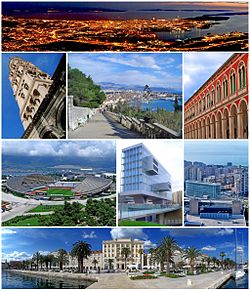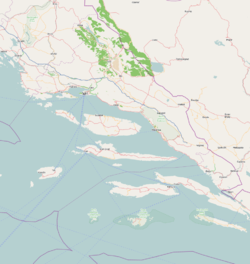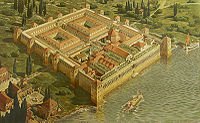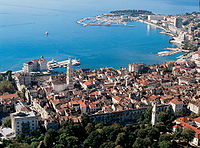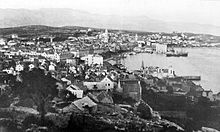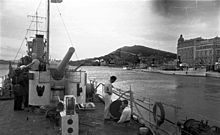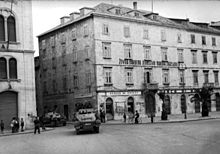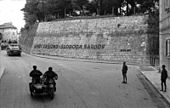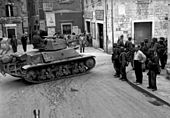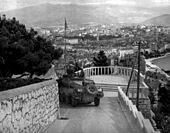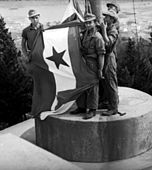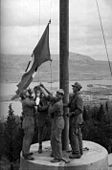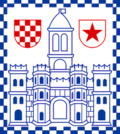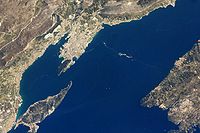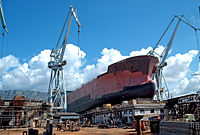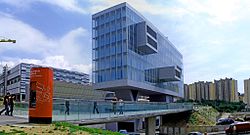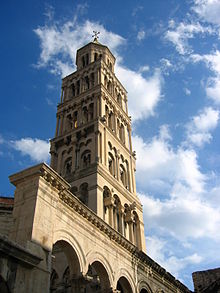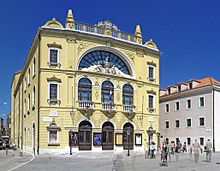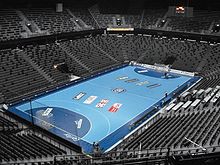- Split, Croatia
-
Split — City — City of Split
Grad SplitSome images of Split and its landmarks. 
Flag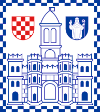
Coat of armsNickname(s): Velo misto (Croatian: "Big City") Motto: Ništa kontra Splita (unofficial) Location of Split in central Dalmatia Location of Split in Croatia Coordinates: 43°30′0″N 16°26′0″E / 43.5°N 16.433333°E Country  Croatia
CroatiaCounty Split-Dalmatia County Greek colony of Aspálathos established 6th century BC Diocletian's Palace built 305 AD Diocletian's Palace settled 639 AD Government – Mayor Željko Kerum Area[1][2] – City 79.38 km2 (30.6 sq mi) – City itself 22.12 km2 (8.5 sq mi) Population (2011)[3][4] – City 178,192 – Density 2,244/km2 (5,811.9/sq mi) – Metro 348,288 – City itself 165,893 – City itself Density 7,499/km2 (19,422.3/sq mi) Time zone CET (UTC+1) – Summer (DST) CEST (UTC+2) Postal code 21000 Area code 21 Licence plate ST Lowest point 0 m Highest point 178m (Marjan) Website www.split.hr Split (Croatian pronunciation: [splît]) is a Mediterranean city on the eastern shores of the Adriatic Sea, centered around the ancient Roman Palace of the Emperor Diocletian and its wide port bay. With a population of 178,192 citizens,[3] and a metropolitan area numbering up to 467,899,[4] Split is by far the largest Dalmatian city and the second-largest city of Croatia. Spread over a central peninsula and its surroundings, Split's greater area includes the surrounding seaside towns as well. An intraregional transport hub, the city is a link to numerous Adriatic islands and the Apennine peninsula, as well as a popular tourist destination.
Split is also one of the oldest cities in the area. While it is traditionally considered just over 1,700 years old counting from the construction of Diocletian's Palace in AD 305, archaeological research relating to the original founding of the city as the Greek colony of Aspálathos (Aσπάλαθος) in the 6th century BC, establishes the urban tradition of the area as being several centuries older.
Contents
Name
The ancient originally city draws its name from the spiny broom (calicotome spinosa; brnistra or žuka in modern Croatian), a common shrub in the area, after which the Greek colony of Aspálathos (Aσπάλαθος) or Spálathos (Σπάλαθος), from which the city originates, was named. As the city became a Roman possession, the Latin name became "Spalatum", which in the Middle Ages evolved into "Spalatro" in the Dalmatian language of the city's Romance population. The South Slavic version became "Split", while the Italian version was "Spalato". During a period in the early 19th century the name was "Spljet", and finally "Split" once more.
Thus, contrary to a number of older theories, the origin of the name is not related to the Latin word for "palace" (palatium), thought to be a reference to Diocletian's Palace which still forms the core of the city. The erroneous "palace" etymology was notably due to Byzantine Emperor Constantine VII Porphyrogenitus, and was later also mentioned by Thomas the Archdeacon.[5]
- Ancient Greek: Aσπάλαθος Aspálathos
- Latin: Spalatum
- Medieval Dalmatian: Spalatro
- Italian: Spalato
History
For more information on the history of Split's region, see History of Dalmatia.Antiquity
Reconstruction of the Palace of the Roman Emperor Diocletian in its original appearance upon completion in AD 305.The modern-day center of Split with Diocletian's Palace in 1997. Visible also are the medieval Varoš district and the Giardin Park.While the beginnings of Split are often connected to the construction of Diocletian's Palace, the city was founded earlier as a Greek colony of Aspálathos. The Greek settlement lived off trade with the surrounding Illyrian tribes, mostly the Delmatae, who inhabited the (much larger) nearby city of Salona.[citation needed] In time, the Roman Republic became the dominant power in the region, and conquered the Illyrians in the Illyrian Wars of 229 and 219 BC. Upon establishing permanent control, the Romans founded the province of Dalmatia [6] with Salona as the capital, and at that time the name of the nearby Greek colony Aspálathos was changed to "Spalatum".[5]
After he nearly died of an illness, the Roman Emperor Diocletian (ruled AD 284 to 305), great reformer of the late Roman Empire, decided to retire from politics in AD 305.[7] The Emperor ordered work to begin on a retirement palace near his hometown, and since he was from the town of Dioclea he chose the harbor near Salona for the location. Work on the palace began in AD 293 in readiness for his retirement from politics. The palace was built as a massive structure, much like a Roman military fortress. It faces the sea on its south side, with its walls 170 to 200 meters (570 to 700 feet) long, and 15 to 20 meters (50 to 70 feet) high, enclosing an area of 38,000 m² (9½ acres). The palace water supply was substantial, fed by an aqueduct from Jadro Spring. This opulent palace and its surroundings were at times inhabited by a population as large as 8,000 to 10,000 people,[8] who required parks and recreation space; therefore, Diocletian established such outdoor areas at Marjan hill.[9] The palace was finished in AD 305, right on time to receive its owner, who retired exactly according to schedule, becoming the first Roman Emperor to voluntarily remove himself from office.[10] After a few years, a group of Roman Senators came to Diocletian's palace, asking the former emperor to return to Rome and help the Empire to overcome growing political problems. Diocletian refused, and while he was showing them his garden, he told them that he could not leave his beautiful garden which he had created by his own hands. This gesture showed that he remained bound by his word to leave political life after 21 years of ruling the Roman Empire.[11]
Following the fall of the Western Roman Empire in AD 476, Spalatum became a part of the Eastern Roman Empire, also known as Byzantium. It grew very slowly as a satellite town of the much larger Salona. However, around AD 639 Salona fell to the invasion of Avars and Slavs, and was razed to the ground[dubious ], with the majority of the displaced citizens fleeing to the nearby Adriatic islands. Following the return of Byzantine rule to the area, the Romanic citizens returned to the mainland under the leadership of the nobleman known as Severus the Great. They chose to inhabit Diocletian's Palace in Spalatum, because of its strong (more "medieval") fortifications. The palace was long deserted by this time, and the interior was converted into a city by the Salona refugees, making Spalatum much larger as the successor to the capital city of the province. Today the palace constitutes the inner core of the city, still inhabited, full of shops, markets, squares, with an ancient Cathedral of St. Duje (formerly Diocletian's mausoleum) inserted in the corridors and floors of the former palace. As a part of the Byzantine Empire, the city had varying but significant political autonomy.
Middle Ages
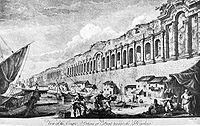 An engraving of the city's seaward walls by Robert Adam, 1764.
An engraving of the city's seaward walls by Robert Adam, 1764.
The Medieval period in Split's Dalmatia province is marked by the waning power of the Byzantine Empire, and by the struggle of the neighboring powers, namely the Venetian Republic, the Kingdom of Croatia, and (later) the Kingdom of Hungary, to fill the power vacuum.[12] The arrival of the South Slavs (mostly Croats) in the 7th century AD profoundly influenced the area. The hinterland and the islands were predominantly populated by the Croats, who began influencing the city itself. The early Medieval Croatian state (later the Kingdom of Croatia) founded neighboring littoral cities (such as Šibenik), and encompassed the vast majority of the hinterland. In the following centuries Split developed an increasingly Croatian character, which can be seen in the architecture (particularly of churches) in the city and its surroundings. The city's Romance population increasingly mingled with the surrounding populace. The city was for the first time fully integrated within the state by Peter Krešimir IV in 1069, and again in 1075 by Demetrius Zvonimir.
To the north, the Venetian Republic began to influence the Dalmatian region from the 10th century, using its growing economic influence to gain control over the islands and the coastal cities. It gained control over the city during several periods, due mostly to the temporary weakness of the Croatian or Hungarian state. With the decline of the Byzantine Empire, the Kingdom of Croatia held de-facto suzerainty over the city, granting it significant autonomy due to the state's feudal character. In the year 1102, Croatia was forced into a personal union with the Kingdom of Hungary (see Croatian pacta conventa) by its King, Coloman. The city however maintained its significant degree of independence, and in 1312, it issued statutes as well as currency of its own.
Early modern period
Overall view of Split in the Early modern period (1764), an engraving by Scottish architect Robert Adam. Marjan hill is visible in the background.City center and the Riva promenade from the slopes of Marjan in 1910During the 20-year Hungarian civil war between King Sigismund and the Capetian House of Anjou of the Kingdom of Naples, the losing contender, Ladislaus of Naples, sold his rights on Dalmatia to the Venetian Republic for 100,000 ducats. The more centralized Republic took over the city by the year 1420, it was to remain under Venetian rule for 377 years (1420–1797).[13]
The population was by that time largely Croatian, while Romance Dalmatian names were not so numerous, according to the Medieval city archives, and the common language was also Croatian, but Italian (a mixture of Tuscan and Venetian dialects) was also spoken due to the Italian minorities.[14] The autonomy of the city was reduced: the highest authority was a prince-captain, always of Venetian birth.
Despite this, Split eventually developed into a significant port-city, with important trade routes to the Ottoman-held interior through the nearby Klis pass. Culture flourished as well, Split being the hometown of Marko Marulić, a classic Croatian author. Marko Marulić's most acclaimed work, Judita (1501), was an epic poem about Judith and Holfernes and written in Split, it was printed in Venice in 1521. It is widely held to be the first modern work of Croatian literature. Still, it should be noted the advances and achievements were reserved mostly for the aristocracy: the illiteracy rate was extremely high, mostly because Venetian rule showed little interest in educational and medical facilities. Split was ruled by the Venetian Republic up to its downfall in 1797. After a brief period of Napoleonic rule (1806–1813) when was even part of the Napoleonic Kingdom of Italy, the city was allocated to the Empire of Austria by the Congress of Vienna. Large investments were undertaken in the city during that period, new streets were built and parts of the ancient fortifications were removed.[15]
During the period of the Austrian Empire Split's region, the Kingdom of Dalmatia, was a separate administrative unit. After the revolutions of 1848 as a result of the romantic nationalism, two factions appeared. One was the pro-Croatian Unionist faction (later called the "Puntari", "Pointers"), led by the People's Party and, to a lesser extent, the Party of Rights, both of which advocated the union of Dalmatia with Croatia-Slavonia which was under Hungarian administration. This faction was strongest in Split, and used it as its headquarters. The other faction was the pro-Italian Autonomist faction (also known as the "Irredentist" faction), whose political goals varied from autonomy within the Austro-Hungarian Empire, to a political union with the Kingdom of Italy.
The political alliances in Split shifted over time. At first, the Unionists and Autonomists were allied against the centralism of Vienna. After a while, when the national question came to prominence, they separated. Under Austria, however, Split can generally be said to have stagnated. The great upheavals in Europe in 1848 gained no ground in Split, and the city did not rebel.
Antonio Bajamonti became Mayor of Split in 1860 for and – except for a brief interruption during the period 1864–65 – held the post for over two decades until 1880. Bajamonti was also a member of the Dalmatian Sabor (1861–91) and the Austrian Chamber of Deputies (1867–70 and 1873–79). In 1882 the Bajamonti's party lost the elections and Dujam Rendić-Miočević, a prominent city lawyer, was elected to the post.
20th century
Kingdom of Yugoslavia
See also: 1918–1920 incidents in SplitAfter the end of World War I and the dissolution of Austria-Hungary, the province of Dalmatia, along with Split, became a part of the Kingdom of Serbs, Croats and Slovenes (which in 1929 changed its name to Kingdom of Yugoslavia). Since both Rijeka and Zadar, the two other large cities on the eastern Adriatic coast, were annexed by Italy, Split became the most important port in Yugoslavia. In the new country, Port of Split became the seat of new administrative unit, Littoral Banovina. The Lika railway, connecting Split to the rest of the country, was completed in 1925. After the Cvetković-Maček agreement, Split became the part of new administrative unit (merging of Sava and Littoral Banovina plus some Croat populated areas), Banovina of Croatia in Kingdom of Yugoslavia.
World War II
Main article: Yugoslav FrontIn April 1941, following the invasion of Yugoslavia by Nazi Germany, Split was occupied by Italy and formally annexed one month later. Italian rule met heavy opposition from the Croat population as Split became a center of anti-fascist sentiment in Yugoslavia. Between September and October 1941 alone, ten officials of the Italian fascist occupation were assassinated by the citizens.[16]
In September 1943, following the capitulation of Italy, the city was temporarily liberated by Tito's brigades with thousands of people volunteering to join the Partisans of Marshal Josip Broz Tito (a third of the total population, according to some sources). A few weeks later, however, the Partisans were forced into retreat as the Wehrmacht placed the city under the occupation of the Nazi puppet NDH a few weeks later. The local football clubs refused to compete in the Italian championship; HNK Hajduk and RNK Split suspended their activities and both joined the Partisans along with their entire staff after the Italian capitulation provided the opportunity. Soon after Hajduk became the official football club of the Partisan movement.
During the occupation, some of the port facilities as well as parts of the old city were damaged by NDH and German bombing. In a tragic turn of events, besides being bombed by axis forces, the heavily pro-Partisan city was also bombed by the Allies, causing hundreds of deaths. Partisans finally liberated the city on October 26, 1944 and instituted it as the provisional capital of Croatia. On February 12, 1945 the Kriegsmarine conducted a daring raid on the Split harbor, damaging the British cruiser Delhi.
German vehicles in the city streets. The sign reads "Death to fascism - freedom to the people".Germans in a Panzerspähwagen Sd.Kfz. 231 half-track, descending from Marjan Hill.German troops lowering the Yugoslav flag from Marjan HillGermans raising the flag of Nazi Germany over SplitSFR Yugoslavia
Main articles: Socialist Federal Republic of Yugoslavia and Socialist Republic of CroatiaAfter World War II, Split became a part of the Socialist Republic of Croatia, itself a constituent sovereign republic of the Socialist Federal Republic of Yugoslavia. During the period the city experienced its largest economic and demographic boom. Dozens of new factories and companies were founded with the city population increasing three times during the period. The city became the economic center of an area exceeding the borders of Croatia and was flooded by waves of rural migrants from the undeveloped hinterland who found employment in the newly-established industry, as part of large-scale industrialization and investment by the Yugoslav Federal Government.
The shipbuilding industry was particularly successful and Yugoslavia, with its Croatian shipyards, became one of the world's top nations in the field. Many recreational facilities were also constructed with federal funding, especially for the 1979 Mediterranean Games, such as the Poljud Stadium. The city also became the largest passenger and military port in Yugoslavia, housing the headquarters of the Yugoslav Navy (Jugoslavenska ratna mornarica, JRM) and the Army's Coastal Military District (equivalent of a field army). In the period between 1945 and 1990, the city was transformed and expanded, taking up the vast majority of the Split peninsula. In the same period it achieved an as yet unsurpassed GDP and employment level, still above the present day's, growing into a significant Yugoslav city.
Republic of Croatia
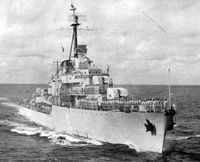 The city was the eponym of several Yugoslav warships, including the destroyer R-11 Split
The city was the eponym of several Yugoslav warships, including the destroyer R-11 Split
When Croatia declared its independence again in 1991, Split had a large garrison of JNA troops (drafted from all over Yugoslavia), as well as the headquarters and facilities of the Yugoslav War Navy (JRM). This led to a tense months-long stand-off between the JNA and Croatian National Guard and police forces, occasionally flaring up in various incidents.
The most tragic such incident occurred on November 15, 1991, when the JRM light frigate Split fired a small number of shells at the city and its surroundings. The damage was insignificant but there were a few casualties. Three general locations were bombarded: the old city center, the city airport and an uninhabited part of the hills above Kaštela, between the airport and Split. JRM Sailors who had refused to attack Croat civilians, most of them Croats themselves, were left in the vessel's brig. The JNA and JRM evacuated all of its facilities in Split during January 1992. The 1990s economic recession soon followed.
In the years following 2000, Split finally gained momentum and started to develop again, with a focus on tourism. From being just a transition centre, Split is now a major Croatian tourist destination. Many new hotels are being built, as well as new apartment and office buildings. Many large development projects are revived, and new infrastructure is being built. An example of the latest large city projects is the Spaladium Arena, built in 2009.
Split is was the seat of an incident in the 2011 Gay Pride, when 10,000 anti-gay protesters started throwing rocks, tin cans, tomatoes, tear gas and glass bottles at the gay activists. Some of the latter, and some reporters, were lightly injured in the riot. Marie Cornelissen, a member in the Parliament of Europe, condemned the violent protesters. The activists were evacuated, and several hundred people were arrested.[17][18]
Geography
Split is situated on a peninsula between the eastern part of the Gulf of Kaštela and the Split Channel. The Marjan hill (178 m), rises in the western part of the peninsula. The ridges Kozjak (779 m) and his brother Mosor (1339 m) protect the city from the north and northeast, and separate it from the hinterland.

80 km (50 mi) to Šibenik 15 km (9 mi) to Kozjak 34 km (21 mi) to Sinj 
30 km (19 mi) to Trogir 
86 km (53 mi) to Imotski  Split
Split 

58 km (36 mi) to Vis 49 km (30 mi) to Hvar 18 km (11 mi) to Brač Climate
Split has a Mediterranean climate; hot, relatively dry summers and mild, wet winters. Average annual rainfall is in excess of 820 mm (32.28 in). July is the hottest month, with an average high temperature around 30 °C (86 °F). January is the coldest month, with an average low temperature around 10 °C (50 °F). November is the wettest month, with a precipitation total of nearly 113 mm (4.45 in) and 12 rainy days. August is the driest month, with a precipitation total of around 43 mm (1.69 in) and 5 rainy days. Winter is the wettest season, however it can rain in Split at any time of the year. Snow is usually exceedingly rare, but the months of December, January and February have each accrued an average of 1 snowy day since record-keeping began. Split receives in excess of 2,600 sunshine hours annually.
Climate data for Split (Marjan Hill) Month Jan Feb Mar Apr May Jun Jul Aug Sep Oct Nov Dec Year Record high °C (°F) 17.4
(63.3)22.3
(72.1)23.2
(73.8)27.7
(81.9)33.2
(91.8)38.1
(100.6)38.6
(101.5)38.1
(100.6)34.2
(93.6)27.4
(81.3)25.8
(78.4)18.1
(64.6)38.6
(101.5)Average high °C (°F) 10.3
(50.5)11.0
(51.8)13.7
(56.7)17.4
(63.3)22.5
(72.5)26.7
(80.1)29.8
(85.6)29.5
(85.1)25.1
(77.2)20.0
(68.0)14.9
(58.8)11.5
(52.7)19.37
(66.86)Daily mean °C (°F) 8.2
(46.8)8.6
(47.5)10.9
(51.6)14.2
(57.6)19.0
(66.2)24.7
(76.5)26.7
(80.1)26.8
(80.2)20.8
(69.4)17.5
(63.5)12.8
(55.0)9.6
(49.3)16.65
(61.97)Average low °C (°F) 5.4
(41.7)5.5
(41.9)7.6
(45.7)10.8
(51.4)15.2
(59.4)18.8
(65.8)21.6
(70.9)21.5
(70.7)18.1
(64.6)14.1
(57.4)9.9
(49.8)6.8
(44.2)12.94
(55.30)Record low °C (°F) −9
(15.8)−8.1
(17.4)−6.6
(20.1)0.3
(32.5)4.8
(40.6)9.1
(48.4)13.0
(55.4)11.2
(52.2)8.8
(47.8)3.8
(38.8)−4.5
(23.9)−6.3
(20.7)−9
(15.8)Precipitation mm (inches) 77.3
(3.043)62.8
(2.472)63.4
(2.496)62.6
(2.465)55.4
(2.181)49.7
(1.957)42.7
(1.681)42.7
(1.681)71.0
(2.795)76.5
(3.012)112.9
(4.445)103.5
(4.075)820.5
(32.303)Avg. rainy days 11 10 10 9 9 9 6 5 7 9 12 12 109 Avg. snowy days 1 1 0 0 0 0 0 0 0 0 0 1 3 Sunshine hours 131.5 147.9 186.8 217.2 273.0 307.4 350.3 324.8 247.3 196.9 130.6 119.3 2,633 Source no. 1: National Meteorological and Hydrological Service (Croatia) [19] Source no. 2: World Weather Information Service [20] Demographics
In the 2001 census, the city of Split had 188,694 citizens.[21] According to the first results of the 2011 census, the city of Split had 178,192 inhabitants.[3] Ethnically, Croats make up 95.15% of the population,[22] and 88.37% of the residents of the city are Roman Catholics.[23]
The settlements included in the administrative area of the City are:[3]
- Donje Sitno, population 314
- Gornje Sitno, population 391
- Kamen, population 1,691
- Slatine, population 1,106
- Split, population 165,893
- Srinjine, population 1,218
- Stobreč, population 2,953
- Žrnovnica, population 3,234
In the wider urban area Split has about 220,000 inhabitants, while there are approximately 410,000 people in the Split metropolitan area.[citation needed] That area includes the surrounding towns and settlements: Trogir, Omiš, Solin, Kaštela, Podstrana, Sinj, Dugopolje, Klis and Supetar on the island Brač. The entire Split-Dalmatia County has around 470,000 residents.[22]
Economy
See also: Economy of Croatia and Croatian privatization controversySplit's economy is still suffering the backlash from the recession caused by the transfer to a market economy and privatization. In the Yugoslav era, however, the city had been a highly significant economic centre with a modern and diverse industrial and economic base, including shipbuilding, food, chemical, plastics, textile, and paper industry, in addition to a large revenues from tourism. In 1981 Split's GDP per capita was 137% of the Yugoslav average.[24] Today, most of the factories are out of business (or are far below pre-war production and employment capacity) and the city has been trying to concentrate on commerce and services, consequently leaving an alarmingly large number of factory workers unemployed.
Brodosplit shipyard is the largest one in Croatia. It employs around 4,000 people, and has built over 350 vessels, including many tankers, both panamax and non-panamax, as well as container ships, bulk carriers, dredgers, off-shore platforms, fregates, submarines, patrol boats and passenger ships. 80% of the ships built are exported to foreign contractors.
The new A1 motorway, integrating Split with the rest of the Croatian freeway network, has helped stimulate economic production and investment, with new businesses being built in the city centre and its wildly sprawling suburbs. The entire route was opened in July 2005. Today, the city's economy relies mostly on trade and tourism with some old industries undergoing partial revival, such as food (fishing, olive, wine production), paper, concrete and chemicals. Since 1998, Split is host to the annual Croatia Boat Show.
Education
There are 24 primary schools and 23 secondary schools including 5 gymnasiums.
University
Main article: University of SplitFurther information: List of universities in CroatiaThe University of Split (Croatian: Sveučilište u Splitu) was founded in 1974. In the last few years it has grown to a big extent. Now it has 26,000 students and is organized in 12 faculties. Currently the new campus is being built, and it will be finished somewhere in 2012. It will house all of the faculties, a large student centre with a sports hall, sporting grounds and a university library.
Culture
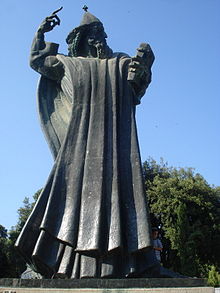 Statue of bishop Gregory of Nin
Statue of bishop Gregory of Nin
In 1979, the historic center of Split was included into the UNESCO list of World Heritage Sites. Split is said to be one of the centres of Croatian culture. Its literary tradition can be traced to medieval times, and includes names like Marko Marulić, while in more modern times Split excelled by authors famous for their sense of humor. Among them the most notable is Miljenko Smoje, famous for his TV series Malo misto and Velo misto, with the latter dealing with the development of Split into a modern city.
Despite colorful settings and characters, as well as a cinema tradition that could be traced to early 20th century works of Josip Karaman, there were relatively few films shot in or around Split. However, the city did produce several famous actors, most notably Boris Dvornik.
Also well known is Ivo Tijardović, and his famous operetta "Little Floramye" (Mala Floramye). Both Smoje and Tijardović are famous artists thought to represent the old Split traditions that are slowly dying out due to the city being overwhelmed by large numbers of rural migrants from the undeveloped hinterland. The old Split families still cling to the littoral Dalmatian way of life and values, often publicly stating their disgust at the ruralization of the ancient city.
Museums and galleries
The Archaeological Museum (Croatian: Arheološki muzej) main collection is housed at Zrinsko-Frankopanska 25 in Split. There is also a branch building in Solin (Salona and Tusculum Collection) and two regional centres at Vid near Metkovic (Narona Collection), and on the island of Vis (Issa Collection). The Split Archaeological Museum is the oldest museum institution in Croatia, founded in 1820 by the decree of the Dalmatian government in Zadar. Some 150,000 artifacts cover prehistoric times, the period of Greek colonization of the Adriatic, Roman Provincial and Early Christian era to the early Middle Ages and the period of Croatian popular rulers). Of special interest is the collection of stone inscriptions from Salona and the collections of Graeco-Hellenistic ceramic objects, Roman glass, ancient clay lamps, bone and metal articles, as well as the collection of gems. In addition, the museum houses an extensive collection of ancient and medieval coins, a submarine achaeological collection, and a rich archive library.[25]
The Museum of Croatian Archaeological Monuments (Croatian: Muzej hrvatskih arheoloških spomenika ) located at Meštrovićevo šetalište 18, is the only museum in Croatia dedicated to researching and presenting cultural artifacts of the Croats in the Middle Ages, between the 7th and 15th centuries, particularly the time of the early medieval Croatian state from 9th to 12th century. Originally founded in Knin in 1893, the museum was moved first to Sinj, then Klis and finally to Split where today the collection is displayed in a purpose-built museum complex, opened in 1976. The holdings consist mainly of jewellery, weapons and items of daily use, and include a large number of stone artifacts that once belonged to the old Croatian church interiors. The collection of early medieval wicker, clay figurines, and old Croatian Latin epigraphic monuments is the largest collection of its kind in Europe.[26]
The Split City Museum (Croatian: Muzej Grada Splita) at Papalićeva 1, is housed in the former Papalić Palace. The collection presents the urban, cultural, artistic and economic heritage of the city. The museum is also home to the Emanuel Vidović Gallery, dedicated to the most important Split painter of the 20th century.[27][28]
The Ethnographical Museum (Croatian: Etnografski muzej) at Severova 1, has a wide range of ethnographic content mainly from Dalmatia. Founded in 1910, the museum collects original and contemporary applications of traditional heritage. They also track contemporary popular culture living with traces of old foundations and preserve and promote the value of folk heritage, renewing them and presenting exhibitions.[28]
The Croatian Maritime Museum (Croatian: Hrvatski pomorski muzej) at Glagoljaška 18 - Tvrđava Gripe has a collection of marine equipment and supplies, weapons and navigation equipment, medals, ship models, uniforms and equipment, and related artwork. A permanent exhibition is planned to complete the presentation of military maritime and naval history, with a presentation that covers the period from the arrival of the Slavs to the present day.[28]
Split Science museum and Zoo (Croatian: Prirodoslovni musej i zooloski vrt) located at Kolombatovićevo šetalište 2 on the Marjan peninsula.[29]
The Gallery of Fine Arts (Croatian: Galerija umjetnina), located at Kralja Tomislava 15, is an art museum that contains works from 14th century to the present day providing an overview of the artistic developments in the local art scene. The gallery was founded in 1931, and has a permanent exhibition of paintings and sculptures that includes works by major Croatian artists such as Vlaho Bukovac, Mato Celestin Medović, Branislav Dešković, Ivan Meštrović, Emanuel Vidović and Ignjat Job. The gallery also has an extensive collection of icons, and holds special exhibits of works by contemporary artists. In May 2009, the gallery opened its new premises in the old Split Hospital building behind Diocletian's Palace.[30]
The Ivan Meštrović Gallery (Croatian: Galerija Meštrović), on the Marjan peninsula is an art museum dedicated to the work of the 20th century sculptor, Ivan Meštrović. The gallery displays some of his most significant work, and the building itself is an art monument.[31] The permanent collection includes works of sculpture, drawings, design, furniture and architecture. The gallery building and grounds were based on original plans by Meštrović himself, and included living and working areas, as well as exhibition spaces.[32] Not far from the Gallery lies Kaštelet-Crikvine, a restored chapel that houses a set of wooden wall panels carved by Ivan Meštrović.[33]
Music
One of the most recognisable aspects of Split culture is popular music. Notable composers include Josip Hatze, Ivo Tijardović, Zdenko Runjić - some of the most influential musicians in former Yugoslavia. Also, the more notable musicians and bands from Split are Oliver Dragojević, Gibonni, Daleka Obala, Magazin, Severina, Dino Dvornik, Jasmin Stavros, Neno Belan, Goran Karan, Dražen Zečić, Doris Dragović, Jelena Rozga, Danijela Martinović, Siniša Vuco, Luka Nižetić and others. There is great cultural activity during summers, when the prestigious Split Music Festival is held, followed by the Split Summer (Splitsko ljeto) theater festival.
Sports
 The Poljud Stadium, innovatively designed, was built for the 1979 Mediterranean Games.
The Poljud Stadium, innovatively designed, was built for the 1979 Mediterranean Games.
Sportsmen are traditionally held in high regard in Split, and the city is famous for producing many champions. The most popular sports in Split are football (soccer), tennis, basketball, swimming, rowing, sailing, waterpolo, athletics, and handball. Residents of Split prefer to call their city as "The sportiest city in the world".
The main football (soccer) club is HNK Hajduk, the most popular club in Croatia supported by a fans known as Torcida Split, while RNK Split is the city's second club. The largest football stadium is the Poljud Stadium (HNK Hajduk's ground), with 35,000 capacity (55,000 prior to the renovation to an all-seater). Slaven Bilić, Aljoša Asanović, Igor Tudor, and Stipe Pletikosa are some of the famous Split natives who started their careers at Hajduk. Basketball is also popular, and the city basketball club, KK Split (Jugoplastika Split), holds the record of winning the Euroleague three consecutive times (1989–1991), with notable players like Toni Kukoč and Dino Rađa both of whom are Split natives.
Split's most famous tennis stars are the retired Wimbledon champion Goran Ivanišević, and Mario Ančić ("Super Mario"). Members of the local rowing club HVK Gusar won numerous Olympic and World Championship medals.
Swimming also has a long tradition in Split, with Đurđica Bjedov (1968 Olympic Gold Medal and Olympic record in the 100 m breaststroke), Duje Draganja and Vanja Rogulj as the most famous swimmers from the city. As a member of the ASK Split athletics club, the champion Blanka Vlašić also originates from the city. The biggest sports events to be held in Split were the 1979 Mediterranean Games, and the 1990 European Athletics Championships.
Split is one of the host cities of the 2009 World Men's Handball Championship. The city constructed a new sporting arena for the event, the Spaladium Arena. Its capacity is 12,000 spectators (in basketball events). The cost of the arena was evenly divided between the city and the government.[34] Ivano Balić, two time IHF World Player of the Year is the most famous handball player to come from Split.
Picigin is a traditional local sport (originating in 1908), played on the famous sandy beach Bačvice. It is played in very shallow water (just ankle deep) with a small ball. Picigin is played by five players. The ball is the peeled tennis ball. There is a tradition of playing picigin in Split on New Year's Day, regardless of the weather conditions, in spite of the sea temperature rarely exceeding 10 °C.
RK Nada are the most successful rugby union club in the Balkan region, with 11 titles in the Yugoslav championship and 14 in Croatia since independence.
Split SeaWolves is the only team of American Football in Dalmatia. Active from 2008. currently still developing and main focus is on flag football team.
Transportation
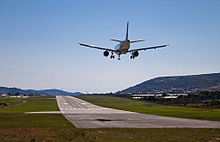 A plane landing at Split Airport
A plane landing at Split Airport
Split is an important transport center for Dalmatia and the wider region. In addition to the Zagreb-Split freeway (A1), all the road traffic along the Adriatic coast on the route Rijeka–Dubrovnik (Adriatic Highway) flows through the city. The city also has a series of expressways and avenues, enabling efficient, fast transit by car around the city and its suburbs. The most important mean of transport in Split is bus, the city being inadequate for trams due to its hilly geography. The local public transport company Promet Split renovated its fleet in 2008 with the latest MAN and Mercedes-Benz models.
Split is also the southernmost integrated point of the Croatian Railway network. Within Split's city centre, railway traffic passes two tunnels before reaching the Central Station. The line to Split is unremarkable; a journey from Split to Zagreb or Rijeka takes around 5 hours, as the line is unelectrified and consists of only one track. Currently, there are no definite plans to upgrade the line, but with the start of work on the new Zagreb-Rijeka railway line in October 2007. The Split Suburban Railway network opened in early December 2006. It currently has one line, running from the Split city harbour to Kaštel Stari. The line is expected to get a second track and be fully electrified in the near future. New, low-floor trains are expected to be implemented as well. This line will also be lengthened, to encompass the aforementioned Split International Airport, and continue on to the towns of Trogir and Seget Donji. Split also plans to construct a mini-metro that is to be operational by 2012.
The Split Airport in Kaštela is the second largest in Croatia in terms of passenger numbers (1,203,778 in 2008), with year-round services to Zagreb, London, Frankfurt and the Cologne Bonn Airport in Germany, as well as heavy tourist traffic in the summer. The expansion of the terminal is scheduled to commence in 2012.
The passenger seaport in Split, with its annual traffic of 4 million passengers, is the third busiest port in the Mediterranean, with daily coastal routes to Rijeka, Dubrovnik and Ancona in Italy. During the summer season Split is connected with other Italian cities as well, such as Pescara. Most of the central Dalmatian islands are only reachable via the Split harbor (with Jadrolinija and Split Tours ferries). This includes the islands of Brač, Hvar and Šolta, as well as the more distant Vis, Korčula and Lastovo. Split is also becoming a major cruise ship destination, with over 260 ship visits, carrying 130,000 passengers. The largest ship scheduled to dock is the 315m long Celebrity Eclipse.
International relations
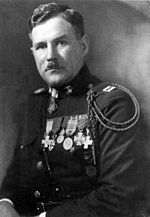 Split-born US marine Major Louis Cukela (Čukela), one of 19 two-time recipients of the Medal of Honor.
Split-born US marine Major Louis Cukela (Čukela), one of 19 two-time recipients of the Medal of Honor. See also: List of twin towns and sister cities in Croatia
See also: List of twin towns and sister cities in CroatiaTwin towns — Sister cities
Split is twinned with:
 Los Angeles, USA
Los Angeles, USA Ancona, Italy
Ancona, Italy Patras, Greece
Patras, Greece Antofagasta, Chile
Antofagasta, Chile Punta Arenas, Chile
Punta Arenas, Chile Bet Shemesh, Israel
Bet Shemesh, Israel Cockburn, Australia
Cockburn, Australia Dover, United Kingdom
Dover, United Kingdom Gladsaxe, Denmark
Gladsaxe, Denmark Mostar, Bosnia and Herzegovina
Mostar, Bosnia and Herzegovina Odessa, Ukraine
Odessa, Ukraine Kermanshah, Iran[35]
Kermanshah, Iran[35]
 Ostrava, Czech Republic
Ostrava, Czech Republic Pescara, Italy
Pescara, Italy Cagli, Italy
Cagli, Italy Beirut, Lebanon
Beirut, Lebanon Štip, Republic of Macedonia
Štip, Republic of Macedonia Bandar Lampung, Indonesia
Bandar Lampung, Indonesia Izmir, Turkey
Izmir, Turkey Trondheim, Norway, since 1956[36]
Trondheim, Norway, since 1956[36] Velenje, Slovenia
Velenje, Slovenia Charlottenburg-Wilmersdorf of Berlin, Germany
Charlottenburg-Wilmersdorf of Berlin, Germany Cetinje, Montenegro
Cetinje, Montenegro Rosario, Argentina
Rosario, Argentina
Images
See also
References
- ^ "Odluka o donošenju Prostornog plana uređenja Grada Splita" (in Croatian). Službeni glasnik Grada Splita (City of Split). 2005-12-13. ISSN 1332-6074. http://www.split.hr/lgs.axd?t=16&id=162. Retrieved 2011-08-08. "Prostorni plan obuhvaća područje Grada Splita utvrđeno Zakonom o područjima županija, gradova i općina u Republici Hrvatskoj („Narodne novine“ 10/97, 124/97, 68/98, 22/99, 117/99, 128/99, 44/00, 129/00, 92/01, 79/02, 83/02) površine 79,38 km2, a čini ga osam naselja."
- ^ "Prostorni plan uređenja Grada Splita" (in Croatian) (DOC). City of Split. p. 1. http://www.split.hr/lgs.axd?t=16&id=2636. Retrieved 2011-08-08. "Tablica 1. Površine katastarskih općina u obuhvatu grada Splita [...] Katastarske općine Split [...] Površina (ha) 2.212 [...] Ukupno površina Grada Splita 7.938 Izvor: Državna geodetska uprava, Područni ured za katastar Split"
- ^ a b c d "Census of Population, Households and Dwellings 2011, First Results by Settlements" (in Croatian and English) (HTML). Statistical Reports (Zagreb: Croatian Bureau of Statistics) (1441). June 2011. ISSN 1332-0297. http://www.dzs.hr/Hrv/censuses/census2011/htm/H11_Zup35_4090.html. Retrieved 2011-08-08.
- ^ a b Slobodna Dalmacija, "Split kao metropola", Split 28 April 2003 [1]
- ^ a b Wilkes, J., Diocletian's Palace, Split : Residence of a Retired Roman Emperor, 17. The name Aspálathos had referred to a white thorn common in the area. Thus, contrary to popular belief, the name "Spalatum" has nothing to do with the Latin word for palace, palatium. According to Wilkes, the erroneous etymology was notably due to Byzantine Emperor Constantine VII Porphyrogenitus.
- ^ John Everett-Heath. "Dalmatia." Concise Dictionary of World Place-Names. Oxford University Press. 2005. Encyclopedia.com
- ^ Gibbon, Edward. The Decline and Fall of the Roman Empire, Modern Library, New York, page 335
- ^ C. Michael Hogan, "Diocletian's Palace", The Megalithic Portal, A. Burnham Ed, October 6, 2007
- ^ Frederick Hamilton Jackson, (1908) The Shores of the Adriatic, J. Murray, 420 pages
- ^ "Diocletian's Palace". W3.mrki.info. http://w3.mrki.info/split/diokl.html. Retrieved 2009-05-06.
- ^ Gibbon, page 336
- ^ History of Dalmatia: 614 to 802 AD
- ^ History: 1301 to 1526 AD
- ^ Novak, Grga, Povijest Splita, Split.,1957
- ^ The Illyrian Provinces, 1809-1813
- ^ Ramet, Sabrina P.; The three Yugoslavias: state-building and legitimation, 1918-2005; Indiana University Press, 2006 ISBN 0-253-34656-8
- ^ http://danas.net.hr/hrvatska/page/2011/06/11/0310006.html
- ^ http://danas.net.hr/hrvatska/page/2011/06/11/0113006.html
- ^ "Monthly Climate Values". Croatian Meteorological and Hydrological Service. http://klima.hr/klima_e.php?id=mjes¶m=01. Retrieved 2010-12-11.
- ^ "Climatological Information". World Meteorological Organization. http://worldweather.wmo.int/019/c00073.htm. Retrieved 2010-12-11.
- ^ "Population by presence/absence in the place of census, by settlements - City of Split". Census 2001. Croatian Bureau of Statistics. 2001. http://www.dzs.hr/Eng/censuses/Census2001/Popis/E01_01_03/e01_01_03_zup17-4090.html. Retrieved 2011-08-08.
- ^ a b "SAS Output - Population by ethnicity". Croatian Bureau of Statistics. 2001. http://www.dzs.hr/Eng/censuses/Census2001/Popis/E01_02_02/E01_02_02_zup17.html. Retrieved 2009-05-06.
- ^ "SAS Output - Population by religion". Croatian Bureau of Statistics. 2001. http://www.dzs.hr/Eng/censuses/Census2001/Popis/E01_02_04/E01_02_04_zup17.html. Retrieved 2009-05-06.
- ^ Radovinović, Radovan; Bertić, Ivan, eds (1984) (in Croatian). Atlas svijeta: Novi pogled na Zemlju (3rd ed.). Zagreb: Sveučilišna naklada Liber.
- ^ "Arheološki muzej [Archaeological Museum]" (in Croatian) http://www.mdc.hr/split-arheoloski/index.html. Retrieved 23 October 2010
- ^ "Muzej hrvatskih arheoloških spomenika [Museum of Croatian Archaeological Monuments]" (in Croatian) http://www.mhas-split.hr. Retrieved 23 October 2010
- ^ "The Split City Museum" http://www.mgst.net. Retrieved 23 October 2010
- ^ a b c "Grad Split [City of Split]" (in Croatian) http://www.split.hr. Retrieved 23 October 2010
- ^ "Prirodoslovni muzej i zooloski vrt [Natural History Museum and Zoological Gardens]" (in Croatian) http://www.mdc.hr/muzej.aspx?muzejId=600%3ASLT. Retrieved 23 October 2010
- ^ "Galerija umjetnina [Gallery of Fine Arts]" (in Croatian) http://www.galum.hr. Retrieved 23 October 2010
- ^ Ivan Meštrović Gallery: Permanent Exhibition Guide. Zagreb: Ivan Meštrović Foundation. 2005. ISBN 953-96956-9-4
- ^ "Meštrović Gallery" http://www.mdc.hr/mestrovic/galerija/index-en.htm. Retrieved 16 October 2010
- ^ "Ivan Meštrović Museums" http://www.mestrovic.hr. Retrieved 16 October 2010
- ^ Cabinet And Split Participate In Financing Hall
- ^ http://www.asriran.com/fa/news/171014/%DA%A9%D8%B1%D9%85%D8%A7%D9%86%D8%B4%D8%A7%D9%87-%D9%88-%D8%A7%D8%B3%D9%BE%DB%8C%D9%84%DB%8C%D8%AA-%D8%AE%D9%88%D8%A7%D9%87%D8%B1-%D8%AE%D9%88%D8%A7%D9%86%D8%AF%D9%87-%D9%85%DB%8C-%D8%B4%D9%88%D9%86%D8%AF
- ^ Trondheims offisielle nettsted - Vennskapsbyer
External links
- Visit Split - The Diocletian's city Photo Gallery and tourist information.
- Official Split web page
- Split, Croatia travel guide from Wikitravel
Cities and major settlements of Croatia by population 100,000+ 35,000+ 10,000+ Beli Manastir · Belišće · Benkovac · Čakovec · Crikvenica · Đakovo · Daruvar · Duga Resa · Dugo Selo · Garešnica · Gospić · Imotski · Ivanec · Ivanić-Grad · Jastrebarsko · Kastav · Knin · Koprivnica · Krapina · Križevci · Kutina · Labin · Makarska · Metković · Našice · Nova Gradiška · Novi Marof · Novska · Ogulin · Omiš · Opatija · Petrinja · Pleternica · Ploče · Poreč · Požega · Rovinj · Sinj · Slatina · Solin · Sveta Nedelja · Sveti Ivan Zelina · Trogir · Umag · Valpovo · Virovitica · Vrbovec · Vukovar · Zaprešić · ŽupanjaSubdivisions of Split-Dalmatia County Cities and towns Municipalities Baška Voda · Bol · Brela · Cista Provo · Dicmo · Dugi Rat · Dugopolje · Gradac · Hrvace · Jelsa · Klis · Lećevica · Lokvičići · Lovreć · Marina · Milna · Muć · Nerežišća · Okrug · Otok · Podbablje · Podgora · Podstrana · Postira · Prgomet · Primorski Dolac · Proložac · Pučišća · Runovići · Seget · Selca · Sućuraj · Sutivan · Šestanovac · Šolta · Tučepi · Zadvarje · Zagvozd · ZmijavciSettlements within the City of Split metropolitan area World Heritage Sites in Croatia Cathedral of St. James, Šibenik · Dubrovnik · Episcopal Complex of the Euphrasian Basilica, Poreč · Plitvice Lakes · Split with the Palace of Diocletian · Stari Grad Plain · Trogir
Categories:- Split
- Cities and towns in Croatia
- Populated coastal places in Croatia
- World Heritage Sites in Croatia
- Port cities and towns of the Adriatic Sea
- Split-Dalmatia County
- Mediterranean port cities and towns in Croatia
- Greek colonies in Illyria
- Greek colonies in Croatia
- Ancient Greek cities
Wikimedia Foundation. 2010.

